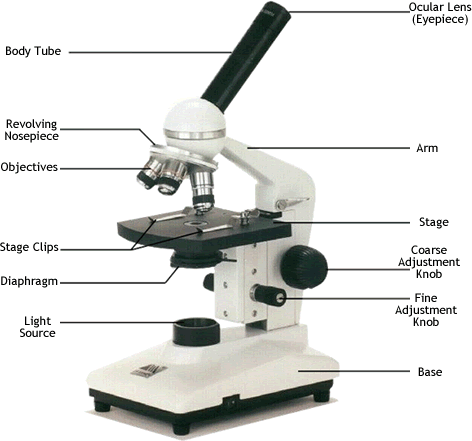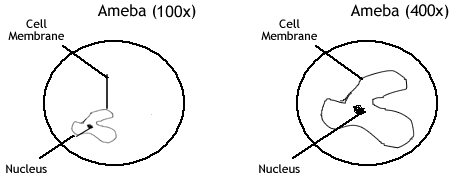How to Use the Microscope
Parts of the Microscope

Quiz Yourself on Naming the Parts of the Microscope!
Print Out a Blank Microscope for Labeling
Magnification
Your microscope has 3 magnifications: Scanning, Low and High. Each objective will have written the magnification. In addition to this, the ocular lens (eyepiece) has a magnification. The total magnification is the ocular x objective
Magnification |
Ocular
lens |
Total
Magnification |
|
| Scanning | 4x |
10x |
40x |
| Low Power | 10x |
10x |
100x |
| High Power | 40x |
10x |
400x |
Focusing Specimens
1. Always start with the scanning objective. Odds are, you will be able to see something on this setting. Use the Coarse Knob to focus, image may be small at this magnification, but you won't be able to find it on the higher powers without this first step. Do not use stage clips, try moving the slide around until you find something.
2. Once you've focused on Scanning, switch to Low Power. Use the Coarse Knob to refocus. Again, if you haven't focused on this level, you will not be able to move to the next level.
3. Now switch to High Power. (If you have a thick slide, or a slide without a cover, do NOT use the high power objective). At this point, ONLY use the Fine Adjustment Knob to focus specimens.
4.
If the specimen is too light or too dark, try adjusting the diaphragm.
5. If you see a line in your viewing field, try twisting the eyepiece, the line should move. That's because its a pointer, and is useful for pointing out things to your lab partner or teacher.
Drawing Specimens
1. Use pencil - you can erase and shade areas
2. All drawings should include clear and proper labels (and be large enough to view details). Drawings should be labeled with the specimen name and magnification.
3. Labels should be written
on the outside of the circle. The circle indicates the viewing field as seen through
the eyepiece, specimens should be drawn to scale. If your specimen takes
up the whole viewing field, make sure your drawing reflects that.
Example:

Making a Wet Mount
1. Gather a thin slice/peice of whatever your specimen is. If your specimen is too thick, then the coverslip will wobble on top of the sample like a see-saw, and you will not be able to view it under High Power.
2. Place ONE drop of water directly over the specimen. If you put too much water, then the coverslip will float on top of the water, making it hard to draw the specimen, because they might actually float away. (Plus too much water is messy)
3. Place the coverslip at a 45 degree angle (approximately) with one edge touching the water drop and then gently let go. Performed correctly the coverslip will perfectly fall over the specimen.
How to Stain a Slide
1. Place one drop of stain (iodine, methylene blue..there are many kinds) on the edge of the coverslip.
2. Place the flat edge of a piece of paper towel on the opposite side of the coverlip. The paper towel will draw the water out from under the coverslip, and the cohesion of water will draw the stain under the slide.
3. As soon as the stain has covered the area containing the specimen, you are finished. The stain does not need to be under the entire coverslip. If the stain does not cover as needed, get a new piece of paper towel and add more stain until it does.
4. Be sure to wipe off the excess stain with a paper towel.
Troubleshooting
Occasionally you may have trouble with working your microscope. Here are some common problems and solutions.
1. Image is too dark! Adjust the diaphragm, make sure your light is on.
2. There's a spot in my viewing field, even when I move the slide the spot stays in the same place! Your lens is dirty. Use lens paper, and only lens paper to carefully clean the objective and ocular lens. The ocular lens can be removed to clean the inside.
3. I can't see anything under high power! Remember the steps, if you can't focus under scanning and then low power, you won't be able to focus anything under high power.
4. Only half of my viewing field is lit, it looks like there's a half-moon in there! You probably don't have your objective fully clicked into place.
Slide Presentation on Using the Microscope
Other Resources on the Microscope
Introduction to the Microscope - E Lab - explore how to use a light microscope (Letter E Slides)
Microscope Coloring - label and color the parts of the microscope
Label the Microscope - simple graphic to practice identifying microscope parts
Microscope Investigation for AP Biology - refresher on how to use a microscope and how to measure viewing field
Cheek Cell Lab - observe cheek cells under the microscope
Observing Plant Cells - microscope observation of onion and elodea
Practice Quiz on the Microscope - hosted by Quizziz
Amazing Low Cost Microscope for Student Use - sold by Amazon